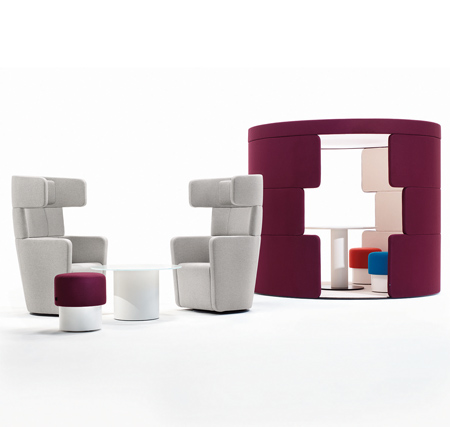London designers PearsonLloyd launched a modular collection of office furniture for design brand Bene as part of Vienna Design Week this month.
Called PARCS, the collection is meant to be configured into informal meeting places and working areas, separated from open-plan desk systems or meeting rooms.
It comprises three main elements - a series of upholstered benches and screens in various heights, a collection of armchairs, sofas and booths, and a round meeting space with low ceiling.
More form PearsonLloyd on Dezeen:
Siren MP3 Player
Rocky collection
Steelcase WorkLife
Link
Here's some more information from Bene:
--
PARCS – Bene launches new meeting environments developed by PearsonLloyd.
PARCS is an innovative furniture programme developed in collaboration between Bene and PearsonLloyd, set to change the design of the workplace.
A new generation of worker is no longer confined to their desk, but instead uses laptop and mobile phone as, when and where it is convenient, comfortable and conducive for concentrating or communicating.
A hybrid between architecture and furniture, PARCS offer a range of different types of places and spaces in which to conduct informal meetings and discussions; take a few minutes away from the desk to relax; give a casual presentation; or find a semi-private place for concentration or a personal call.
PARCS makes sense of the open areas set apart from the open-plan desks and cellular meeting rooms. These places and chance encounters often produce moments of inspiration and positive actions. Seemingly simple, PARCS is the result of 2 years’ research and investigation into the complex needs and behaviour of the ‘knowledge worker’.
Bene regards PARCS as a directional furniture programme that anticipates the way the work-place is changing. PARCS complements Bene’s extensive range of office furniture – desks, seating, conference tables, as well as partitioning. It provides its clients with a comprehensive offer to address every aspect of effective, efficient and economic office design.
Designers PearsonLloyd have drawn on their experience of managing complex environments such as aircraft interiors, cities and the workplace to inform PARCS development and its potential arrangements. However, it is important to emphasise that PARCS combinations are not prescribed. Indeed the intention is for architects and workplace designers to create bespoke configurations from the available programme. Observations of people’s behaviour and interaction at places such as The Giants Causeway in Ireland and the Spanish Steps in Rome were sources of inspiration for different elements. The Toguna references the low-ceilinged meeting places of the Dogon Tribe in Mali, Africa where tribal elders have to sit and thus avoid confrontational argument.
The main elements are:
CAUSEWAY – a series of varied height, upholstered benches and fences that defines a new type of semi open space and encourages sitting, perching, leaning for a variety of different uses.
WING – armchairs, sofas and booths that afford comfort and privacy for small group discussion or concentration.
TOGUNA – a new definition of semi private meeting space.
The Idea Wall and Library augment Causeway elements, respectively providing audio-visual, information technology presentation facilities, and storage for periodicals and books.
All the products have an elegant, quiet aesthetic form which can be personalised by the choice of fabric cladding. Adaptable and flexible, PARCS is also easy to move, adding to its inherent value and attractiveness as it is quick and economic to create a range of meeting environments that do not require architectural intervention or structural elements. Without specific physical boundaries to confine the meeting area, down lighting subtly defines spatial limits.
PARCS has been described as ‘a hybrid between architecture and furniture’ but ultimately the theory translates into tangible evidence when you see people using it. Some 50 projects with international clients are currently in discussion. Beyond the workplace, PARCS is so versatile that it is easy to imagine it being adopted in receptions, break-out areas, and social spaces within the public and private sector organisations as well as hotels.

